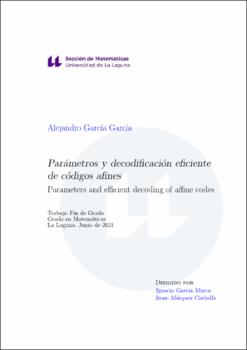Parámetros y decodificación eficiente de códigos afines
Autor
García García, AlejandroFecha
2021Resumen
The main goal of Coding Theory is to efficient transfer reliable information through a channel with noise. This noise may distort the
message so the aim is to recover the original message despite of the
errors that may have occurred. The source will change the original
message by a process called encoding, adding redundant information
and, after that, the source will send the message through the channel.
Once the encoded message is recieved, it starts the most difficult problem, decoding. The goal of this process is to obtain an estimate of
the original message from the received message. This theory looks for
families of codes that allow detecting and correcting as many errors
as possible and that have efficient encoding and decoding procedures.
An efficient way of encoding is to use linear maps, which is translated
as using linear codes. This family of codes and its properties are
introduced in Chapter two. An interesting family of linear codes are
affine codes, we will focus our attention to these codes in Chapter
three. One of the main goals of this Chapter is to give an lower bound
of the minimum distance. In the literature this bound is known, but
it makes use of powerful algebraic tools such as Gr¨obner bases. One
of the key ideas of this Chapter is to present this result but free of
Gr¨obner tools. At the end of Chapter three we will introduce some
well known families of affine codes. For some of these families we
will present, in Chapter four, efficient decoding algorithms. La Teor´ıa de C´odigos busca transmitir de manera eficiente y sin
errores un mensaje entre un emisor y un receptor a trav´es de un canal con ruido. Este ruido puede causar errores en el mensaje, luego
el objetivo es recuperar el mensaje original a pesar de los errores
que se hayan cometido. El emisor transformar´a el mensaje original
mediante un proceso llamado codificaci´on, a˜nadiendo informaci´on
redundante, y lo enviar´a por el canal. Una vez se reciba el mensaje, comienza el proceso m´as dif´ıcil, la decodificaci´on, que consiste
en recuperar el mensaje original a partir del mensaje recibido. Esta
teor´ıa busca familias de c´odigos que permitan corregir una cantidad considerable de errores y realizar los procesos de codificaci´on
y decodificaci´on de manera eficaz. Una forma eficiente de realizar
el proceso de codificaci´on es utilizar aplicaciones lineales, lo que se
traduce en usar, en particular, c´odigos lineales. En el cap´ıtulo dos
introduciremos este tipo de c´odigos y sus propiedades.
Una familia interesante de c´odigos lineales son los c´odigos afines,
en los que nos centraremos en el cap´ıtulo tres. En este cap´ıtulo uno
de los objetivos ser´a dar una cota para la distancia m´ınima de estos c´odigos. En la literatura esta cota es conocida, pero hace uso de
herramientas algebraicas potentes como son las bases de Gr¨obner.
Una de las novedades de este trabajo es presentar este resultado sin
emplear esta herramienta. Al final del cap´ıtulo tres introduciremos
las familias m´as conocidas de c´odigos afines. Para algunas de estas familias, presentaremos, en el cap´ıtulo cuatro, decodificadores
eficientes.





